London 2012 Olympic long jump champion Greg Rutherford addresses viewers providing in-depth analysis of the speed, steps, trajectory angle and air-time of his winning jump of nine years ago.
“As you can see, the angle of the jump has gone up to a 36-degree angle and interestingly as the angle goes up the flight time goes up as well,” Rutherford explains, providing a virtual presentation. “So we’re in the air that little bit longer which actually gives me that opportunity to make sure that I really kick those legs out.”

Rutherford’s segment is just a sample of the augmented reality (AR) technology coming from the sleek-looking Cube Studio that Discovery and Eurosport will utilize during throughout its Tokyo 2020 coverage Tokyo 2020. All of which was highlighted during a sneak peak to select media provided by the European Olympic broadcaster.
The three-level Cube studio will bring together presenters, analysts, and athletes from seven immersive real-time locations utilizing its teleport technology.
Discovery Sports head of production Scott Young and president Andrew Georgiou discussed the European broadcasters latest cutting-edge technologies and elaborate Olympic linear and digital coverage planned, standing side-by-side, virtually, in the London based Cube studio.

“This is virtual studios next levels – it’s extraordinary and world class,” Young says, teleported to the Cube studio from the IBC in Tokyo.
“Innovative, immersive technology such as the Cube is one of the ways that Discovery will enable the audience to take this journey with us,” Georgiou says, while at the Cube studio in London. “You’ve got different ways of creating different atmospheres which is a little more authentic for the viewer to experience the Games.
While Discovery’s studio coverage originates from London, 360-degree beauty shots of Tokyo and varying weather elements will be used as virtual backdrops.
“How we react to weather in the environment is a key piece and you can see the trees and plants behind you, we can make them sway in the background,” Young says.
“From an athletes perspective, when they come into the Cube, it’s a green box and the great thing is that the athletes can actually see you in the screen,” Young explains, referring to athletes joining the multi-location Cube studio remotely.
The first iteration of the Cube was used during Eurosport’s PyeongChang 2018 coverage and also during the broadcaster’s Grand Slam tennis coverage, but Young insists it will be taken to all new levels for Tokyo 2020.
Young also detailed Eurosport and Discovery’s elaborate and extensive coverage, as Discovery prepares to broadcast its first Summer Olympics.
“How we send content around our platforms and our market across Europe is unlike any other broadcaster - we are the most complex sports broadcaster in the world,” Young says,. “We have 50 markets, across 19 languages and we have an extraordinary breadth and depth of storytelling.
“We have hundreds of people here onsite and thousands of people across Europe to connect this content to our markets,” he said. “From our location here at the IBC, we’ll send 164 feeds back to our centers in London and Paris before we distribute them to our 11 broadcast markets.”

Discovery Eurosport will air up to 4,000 hours of Olympic coverage on its TV and digital platform. Some 150 presenters and athlete analysts will coordinate with 400 commentators calling action from 6,300 sessions. Digital platforms include Discovery+, Eurosport Player and Eurosport Dot Com, in addition to the various linear channels across the markets.
“Our content is going to be immersive and the storytelling is going to be magnificent,” Young said.
Georgiou elaborated on the varying difficulties and challenges of producing the Games in the current Covid environment.
“We’ve certainly adjusted our production plans in terms of getting people on the ground and meeting some of the hurdles and challenges, and being respectful of the folks in Japan,” Georgiou said. “It’s difficult to know what to expect.”
Another coverage restriction that needed to be overcome, considering the Covid-19 countermeasures, is that broadcasters are not permitted inside the various NOC houses to interview athletes. Young said a three-camera shoot had initially been planned inside the German NOC house.
“We’re working with the NOC houses where we can install remote cameras so we can engage with the athletes without actually needing to walk into their bubble,” Young advises. “We can place technology within a select number of houses so we can have remote conversations with them.”
Discovery Announces Partnership with YouTube
Discovery and YouTube have reached an agreement in which a selection of Tokyo 2020 highlights will be published via Eurosport’s YouTube channel for fans across Europe.
The new content and advertising partnership will bring Tokyo 2020 moments to new and different audiences across Europe on-demand. The agreement builds on Discovery’s position as the “Streaming Home of the Olympics in Europe”, showcasing the availability of special moment live for fans on discovery+ and Eurosport services.
Designed to keep audiences updated with the Games and showcase the full Olympic Games offering on discovery+ and Eurosport services, Eurosport YouTube Channel will host regular clips during the Games, including on-demand highlights, daily recaps and athlete spotlights. It will also present live-streamed simulcast coverage of the Tokyo 2020 opening and closing ceremonies.
“Working with YouTube to provide on demand Tokyo 2020 content is a great opportunity to make new connections with audiences,” Young said about the partnership. “It offers them new ways to find our content and be introduced to Discovery’s full Olympic Games offer. We can’t wait for the Games to start.”
Written and reported by Brian Pinelli
Últimas Noticias
New IOC members elected, Tokyo 2020 organizers praised as IOC session ends

Karate stars on its Olympic debut as all eight golds go to different nations

U.S. Sweeps Olympic golf gold medals as Nelly Korda claims victory

Japan, Italy and Serbia strike for gold on day two of karate competition

Heavyweight glory for USA’s wrestling phenom Steveson, who nets $250,000 for his last-second win




